HISTORY OF THE ALHAMBRA OF GRANADA
The History of the Alhambra is linked to the geographical location where it is located, Granada; On a rocky hill of difficult access, on the banks of the river Darro, protected by the mountains and surrounded by forest, among the oldest districts of the city, the Alhambra rises like an imposing castle of reddish tones in its walls that hide to the Exterior the delicate beauty of its interior.
Designed as a military zone at the beginning, the Alhambra became the royal residence and court of Granada in the mid-13th century after the establishment of the Nasrid Kingd and the construction of the first palace by the founding king Mohammed ibn Yusuf Ben Nasr, better known as Alhamar.
Throughout the XIII, XIV and XV Centuries, the fortress becomes a citadel of high walls and defensive towers, which houses two main areas: the military zone or Alcazaba, barracks of the royal guard, and the Medina or palatine city, where the famous Nasrid Palaces and the remains of the houses of nobles and plebeians who lived there. The Palace of Carlos V , (built after the city was seized in 1492 by the Catholic Monarchs) , Is also in the Medina.
The monumental complex also has an independent palace in front of the Alhambra, surrounded by orchards and gardens, which was the solace of the Granadine kings, The Generalife .
The name Alhambra has its origins in an Arabic word meaning "red castle or vermilion", perhaps due to the color tone of the towers and walls that completely surround the hill of La Sabica, which under the light of the stars is Of silver color, but in the light of the sun acquires a golden tone. Although there is a more poetic explanation, narrated by the Muslim chroniclers who talk about the construction of the Alhambra "under the light of the torches." Created originally for military purposes, the Alhambra was a fortress, a palace and a small Medina, all at the same time. This triple character helps us understand the many characteristics of this monument.
There is no reference to the Alhambra as a residence of kings until the 13th century, although fortification has existed since the 9th century. The first kings of Granada, the Zirtians, had their castles and palaces in the hills of Albaicin, and nothing remains of them. The monarchs Ziries were in all probability the emirs who built the Alhambra, beginning in 1238.
The founder of the dynasty, Muhammed Al-Ahmar, began with the restoration of the old fort. His work was completed by his son Muhammed II, whose immediate successors continued the repairs. The construction of the palaces (called Casa Real Vieja) dates back to the 14th century and is the work of two great kings: Yusuf I and Muhammed V. The first is awarded, among others, the Fourth Comares, the Door of Justice , The Baths and some towers. His son, Muhammed V, completed the beautification of the palaces with the Hall of Lions, in addition to other rooms and fortifications.
The Alhambra became a Christian court in 1492 when the Catholic Monarchs conquered Granada. Later, several structures were built to house prominent citizens, military barracks, a Church and a Franciscan Monastery.
Days in the Gardens of Spain
Written by Donald Scurr
https://archive.aramcoworld.com/issue/199105/days.in.the.gardens.of.spain.htm
We pass through the entrance into a cool, dappled world of shady trees, screened from the sun's glare by moist foliage and soothed by the sound of running water. With relish, we note a remarkable drop in the temperature: There's a difference of about 17 degrees Centigrade (30°F) between this inner courtyard and the outer one where we waited in sweaty discomfort. The relief is magical - but what's the explanation?
Can the transformation be natural? Is it some secret of the gardener's art? And who were the gardener-wizards who subdued the strength of the sun itself?
The beauty of alabaster, the slenderness of marble pillars and the two-colored stone of the arches in the palace's dark interior reveal the answer: The Alhambra and its gardens were built by the Arabs who ruled and populated this part of Spain for 800 years, and whose civilization flowered here as nowhere else since 1492. Their arts embraced not only the creation of exquisite architecture but also the talents of Arab gardeners, masters at providing relief from inhospitable climates. The enchanting Generalife pleasure gardens of the Alhambra (known to the Arabs as Jannat al-'Arif).
It was Spain's Arab rulers who introduced the art of water gardening to Granada - the art that used the desert-dweller's supreme luxury to devise a refreshing private retreat in the midst of baking heat. When the Arabs arrived in Spain, they brought with them the skills to recreate such gardens, mingling trees and shrubs with water courses, fountains and cascades. There, one could enter a world where streams murmured into pools of sparkling water - pools lined with blue ceramics to increase their apparent depth - to soothe the body and refresh the spirit.
It has been estimated that during the Arabs' dominion in Spain there were 50,000 villas with water gardens in the Seville district alone. The gardens offered irrigation for the diversity of plants that the Arabs loved. Flowers, fruits and vegetables were mixed without inhibition; the Arab gardener saw beauty equally in onion or bougainvillea, artichoke or jaca-randa. Aquatic plants and animals were cultivated where sheets of still water captured glints of light. These were serene places, free from the tyranny of the sun's glare - and they are part of the heritage and the soul of Spain today.
Donald Scurr is a London-based free-lance journalist with a great affection for Spain.
This article appeared on pages 42-48 of the September/October 1991 print edition of Saudi Aramco World.
The Alhambra gardens are composed of anything that can provide pleasure to the five senses: Color, light, aromatic plants and the murmur of water. The whole garden brings an atmosphere of sensuality. The Arab gardens are the representation of the longing for paradise. The idea of paradise in the Muslim culture, is seen as a garden full of delights and pleasures where the man can achieve full satisfaction.
In this concept water plays a major part. Water ensures the abundance of vegetation. The water element is present in fountains, sources, ponds and wise gadgets. The Alhambra gardens have beautiful water features due to the skilled Arabs working with water The water was brought from the foothills of the mountains to water these beautiful gardens that form nowadays the Alhambra Gardens.
The walls mention the beauty of the garden with decoration of floral motifs and coloured shades. The intensive use of colorful tiles is also a characteristic of the Arab Gardens.
https://visitgranada.net/alhambra/alhambra-gardens/
Plants were chosen for their colour or shape. The selection of flowering periods would cover different times and seasons. Pansies and marigolds would have been planted.
Even though you may seen bougainvillea at the Alhambra today, this was not introduced until the 18th century. Magnolia trees were a status symbol. This evergreen plant was expensive and difficult to obtain. There would have been several around the Alhambra palace gardens.
Cypress trees or Oleander bushes become architectural features. Lining walkways or create structure to different sections of the grounds. Cypress trees can live up to 600 years. Used since roman times, the arabs increased their use across Spain.
Box hedges give shape and structure in many gardens at the palace. Climbing plants and trailers are used to cover walls or uninteresting spaces. Examples are wisteria, ivy, jasmine, roses and trumpet creeper.
Certain plants and trees were selected for their scent. Or even for their sensorial qualities, to uplift the spirit. Jasmine of course is perhaps the most obvious plant. Used in perfumes, it was also used in medicine to treat headaches or a sedative. (dried flower treatment)
Orange trees were appreciated for their fragrant blossom. Called Azahar in Spanish. Seville Orange trees were introduced from Asia by the Arabs around the 9th century and are a key feature of islamic gardens.
Roses at the Alhambra
Roses were very important in these gardens too. Used in many different ways, in climbing displays or planted in formal gardens. The damascus rose is still grown at the Alhambra now. Present in the original gardens, rose oil would have been used to perfume rugs and in treatments at the hammam.
Lavender, rosemary and thyme were all fragrant and medicinal plants popular throughout history. At the Alhambra Almond and horse chestnut trees were also present specially for their aroma.
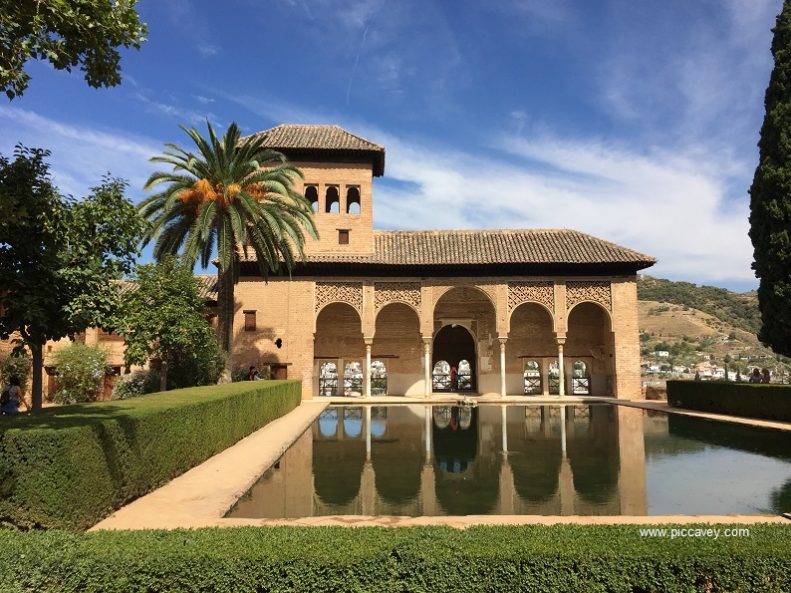
Partal
The large pool outside the Palacio del Partal dominates the space, with the Oratory to one side. In fact this area of garden is probably the oldest that we visit in the present day. The Partal gardens are in two sections. Lower (seen above) and upper section (close to the Santa Maria de la Alhambra Church). This upper area used to be streets and buildings.
Connecting the main street ´Calle Real´ to the Partal and Nasrid palace. On the right next to the qubba (heading towards the garden exit) you may notice the large Crape myrtle tree with its pink blooms. Note in this upper section the waterlilies and frogs in the pond as you move upwards towards Calle Real.
Did you know that the palace used Waterlilies to create room scents?
The Generalife
The name of the Generalife comes from the arabic Jinnah al´ Arif – Garden of the illustrious ones. As we enter the Generalife the first part is the Patio de la Acequia. This islamic garden has altered since the 13th century. Although the main part of the original layout is still clear to see today.
The main focus is the water feature in this garden and the sensation of peace as you hear the movement of the water. The pomegranate trees and large bouganvillea are the most important plants to note in this section of the garden.
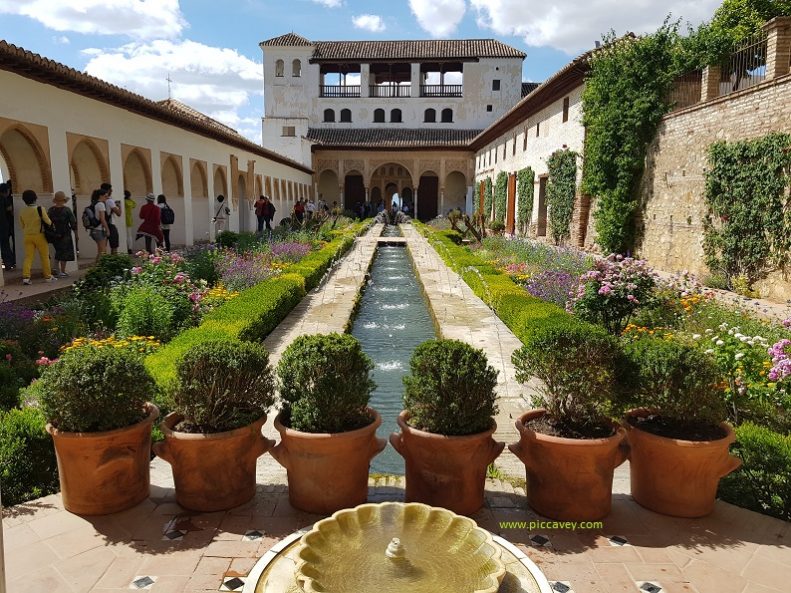
Generalife Lower garden
Continuing past the Patio de la Acequia and moving upwards we come to the Cypress of the Sultana. There could have been a medieval hammam on this site. These fountains were an addition from 16th century.
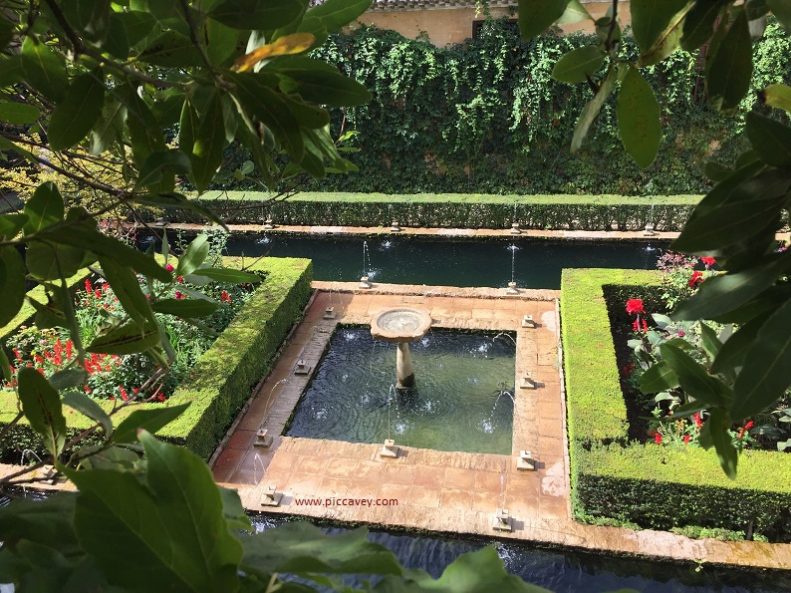
Generalife Upper Garden
Again moving up the stairs past the lions above the stone staircase, we come to the Upper Gardens. From here you can enjoy views of the Alhambra Palace and the city of Granada below. This section of gardens is the newest from 19th century and is a more formal garden design. With box hedges low fountains and a notable magnolia. This leads up to one of my highlights of the Generalife.
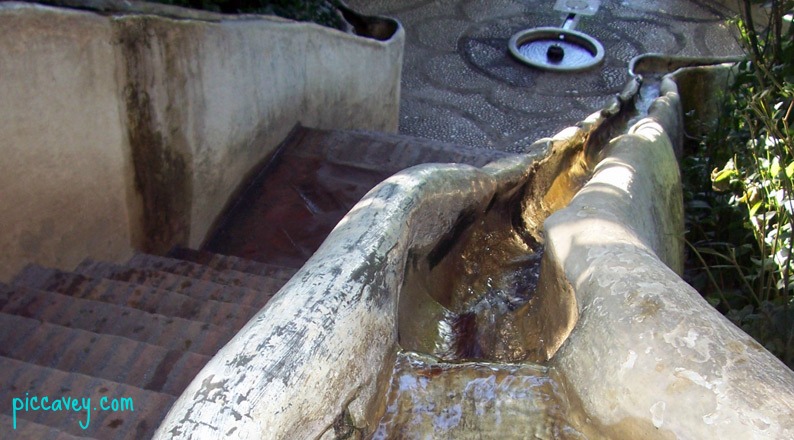
Escalera de Agua
The staircase known as Escalera de Agua has been a feature since the 16th century. Connecting the upper gardens and lower ones, this staircase has three flights. All covered with an archway of greenery to create shade.
The handrail has running water all the way along, creating a fresh atmosphere on hot summer days.
THE ALHAMBRA GARDENS IN ANDALUSIA – A SECRET GUIDE
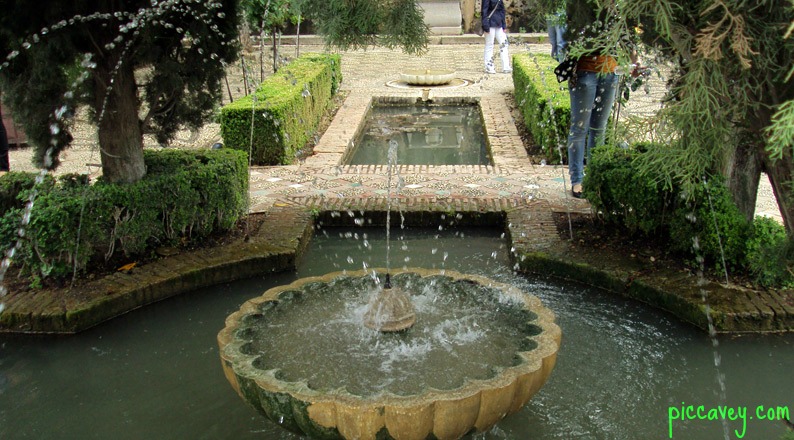
Can you imagine the Alhambra palace without water?
It´s almost impossible to imagine this space without the fountains, pools and water features. Many of the decorative elements of this magnificent monument are created or enhanced with water.
The use of water in the Alhambra palace changed the Sabika hill from a red dusty mound into a lush oasis. Construction in this area of the city is thought to have begun as far back as the 9th century.
The Alhambra Palace, Granada
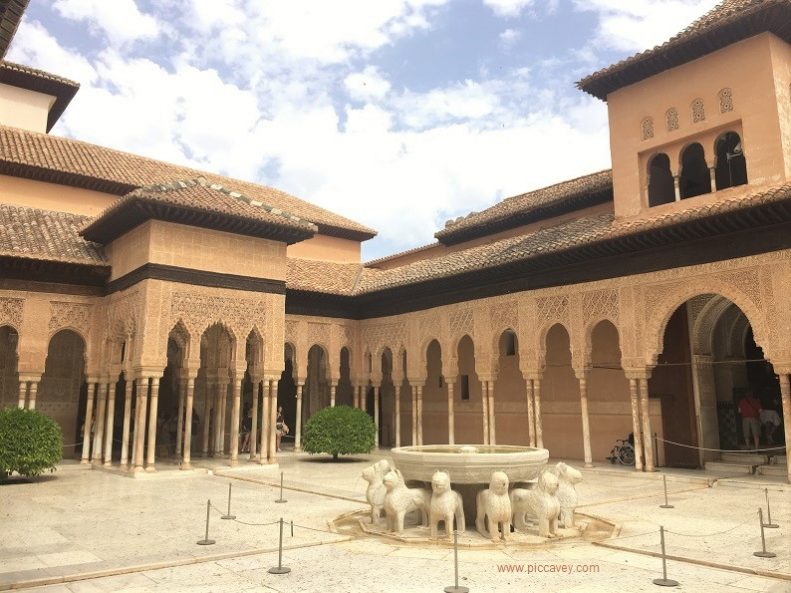
Courtyard of the Lions
Around the 1360´s is when the palace as we know today really begins to develop. The Patio de los Leones or Courtyard of the Lions was built then. Now this is the most emblematic part of the Alhambra. This fountain is said to represent the heavenly garden of Islam. A large bowl sits on twelve lions; each one has its own individual markings and face. Underneath the base of Lion´s fountain run four water channels.
These streams symbolize the four rivers of paradise. Each of the twelve lions spout water into channels below which run across the marble courtyard, creating movement and sounds across the centre of the palace.
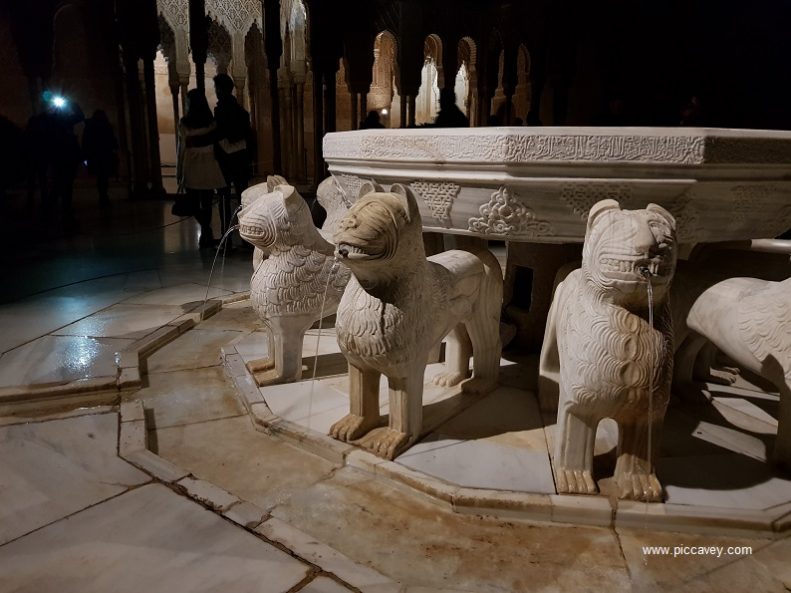
Fountains in the Alhambra
In 2010 a major restoration project helped to conserve the stone lions. Some of the stone and metal parts had rust stains after standing for so many years. This restoration work lasted more than a year. However it didn’t only allow for cleaning up the lions. This restoration revealed far more information about the water supply and engineering of the fountain than was first expected. This central feature had its own water channel. The water supply wasn´t from the same channels which gave water to the Alhambra gardens and fountains.
This had its own exclusive channel which runs in parallel to the main channel from the acequia real. This is a bold and extravagant detail which helps us to understand the importance of the architecture in the Alhambra and the splendor the creators wanted to display.
The patio of the lions is the centre of the Nazrid palace. The most beautiful part of the Alhambra palace. All rooms and corridors radiate from this central courtyard and fountain.
So it was imperative that a constant supply of water arrived to this emblematic part of the palace.

Acequia Real
The Acequia Real is the main water channel which carries the water supply to the Alhambra palace. This 6 km stretch of water above the Darro River. At the time of Nasrid dynasty this water source was clean and suitable for drinking. This network of channels would have ran along to directly into the Generalife Gardens and then through the heart of the Alhambra palaces. The Acequia Real supplied the whole Alhambra citadel with water in a clever network of channels. Water reached all the gardens, plants and even the fountains wih enough pressure and still works all these years on
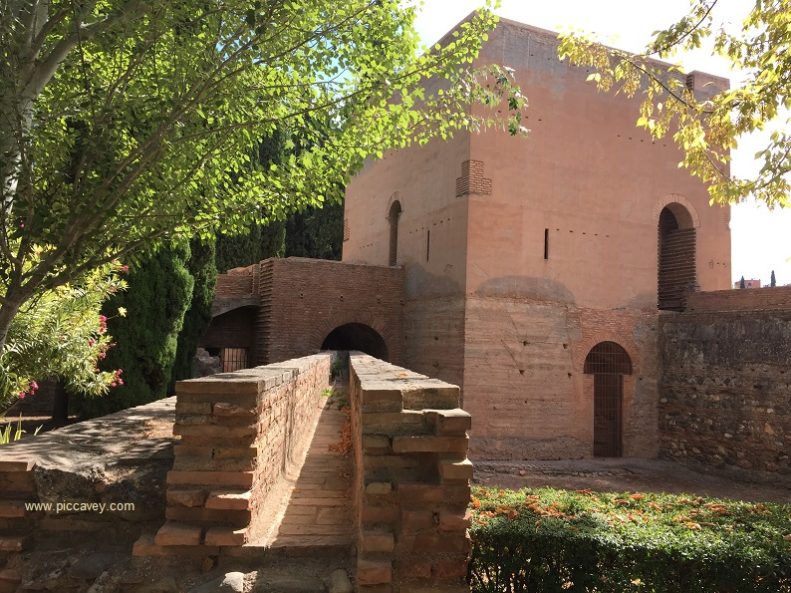
Visiting the Alhambra
When you visit the monument you can see the Acequia Real if you lookout for it. Close to the the entrance to Alhambra Palace you can see one of the arched aqueducts. The design of this system ensured a constant flow of water, refreshing this palatial city. The builders made detailed calculations to use the natural flow of the Darro River. They created a pressure which would make the water flow naturally along its course. As well as the channels, several pools storing water, waterwheels and other devices made this system work.
In 711 Arab settlers had already discovered roman water channels. The engineers for the Alhambra made use of this existing framework to create their own system. Expanding and improving what was already there. They built main channels and sub channels to create a large network. This system also encouraged agriculture in the area. It was working up until 1492 when the Catholic Kings took over Granada. They didn´t understand this system and it did not maintain it well. The Arabs carefully cleaned this water network each year to secure their clean drinking water.
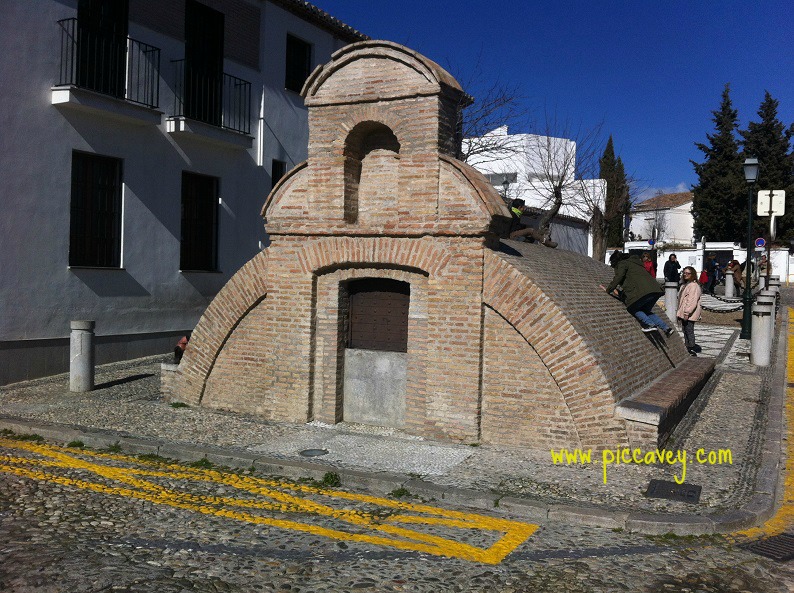
Aljibes
Next to the Puerta del Vino and the Torre de la Vela you come to a large open space known as the Plaza de los Aljibes. This means the square of the water tanks. Aljibes are large deposits for water storage. They are typical in Granada. Many of them are still in the Alhambra and Albaicin neighbourhoods. In 1494 the Count of Tendilla built a 34 metre long water tank under this square.
Years ago there used to be a kiosk on the square which handed out glasses of drinking water from the underground cistern to thirsty visitors. Now there is a kiosk here but unfortunately just selling beer and ice cream.
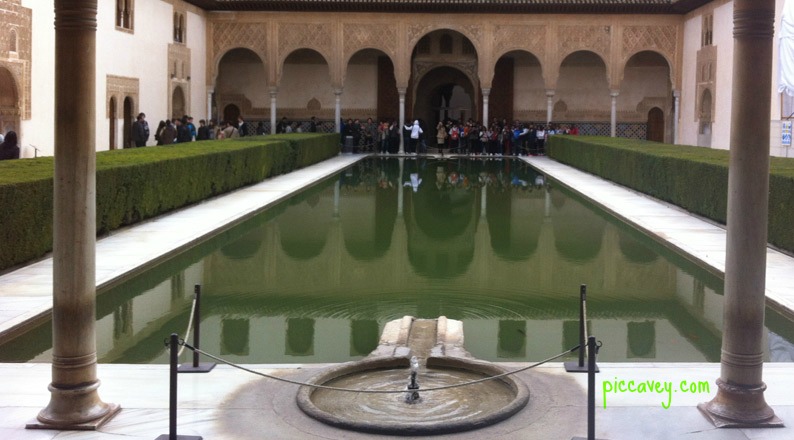
Alhambra Palace Reflections
Patio de los Arrayanes or the court of the myrtles is a perfect example of the use of water in the Alhambra palace. This elongated pool seems to increase the size of the palace, by its captivating mirror effect. The grandeur of the palace is amplified by reflections of the intricate arches in the water.
The babbling sounds of the small fountain at the end of the pool soothes the onlooker. The myrtle hedge around this pool releases a delicate scent when in flower. The architects considered the all five senses when designing these spaces.
Here you can see water shooting up forming silver arches above the plants and the rectangular pool. Similarly the large courtyard also offers views over the city of Granada on the left of this patio.
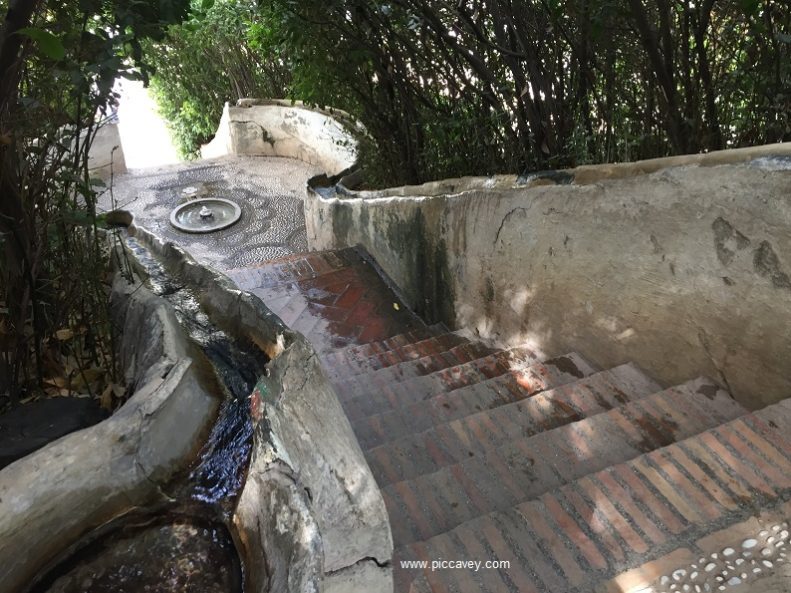
However my own personal highlight in the Generalife gardens is not this area but the Escalera de agua. Known as the water stairs this feature dates from the 16th century. It is a long staircase set amongst bushes and trees. It has water splashing down inside the hollow hand rail and is a unique and eyecatching sight.
The architects of the Alhambra certainly knew how to use the abundance of water to reduce high summer temperatures. Also knowing how to amplify the prestige and power of the monarchs of the time.
https://www.piccavey.com/secrets-alhambra-palace-water/

The Alhambra Palace is the only medieval palace in the world which has arrived intact to the present day.
After visiting many times, one of the things which fascinates me are the intricate details on the walls. As you step into the Nasrid Palaces it is like walking into an elaborate poetry book. Covered in beautiful words and phrases.
I wonder what is the meaning of all of these inscriptions?
Some inscriptions are beautiful poetry whereas others provide information on construction dates of building within the Alhambra
Another thing that these walls offer are clues into the functionality of different spaces around the monument.
Alhambra Palace Walls
Even more inscriptions cover phrases such as “There is no victor but Allah” which appears many times. Also recurring words like “happiness” or “blessing” appear often throughout the palace. These words are there to protect the monarch honoured in each courtyard.
Similarly other phrases appear such as: “Rejoice in good fortune, because Allah helps you” or “Be sparse in words and you will go in peace.”
It seems like the men choosing these texts for the palace walls were poets but also politicians. This wall decoration was an elaborate form of political propoganda. These palace officials reflected the authority and power of the Sultan. Visible to anyone entering the rooms at the heart of the Al Andalus kingdom.
Mosaics and Coloured Tiles
As you wander along the maze like corridors of the palace, you will see many walls covered in brightly coloured ceramic tiles. The tiles cover half of the walls. of this increible interior we can appreciate this is a key element in Islamic art. As this historic period is of great importance, we can still see coloured tiles across Andalusia today.
Futhermore these tiles apart from being decorative, keep walls cooler in summertime and protect them too. Tiling done with mathematical precision was intended to be aestetically pleasing. Geometrical calculations were used in the tile patterns.
Creating an infinite design to cover as much distance as needed for each space.
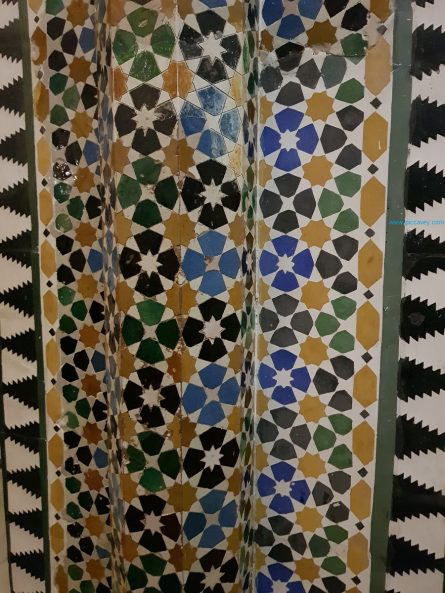
Granada
The façade of the Cuarto Dorado has impressive decoration. The walls are golden in a delicate filigree pattern. The detailed shapes are floral and geometric forms. Due to this extensive detail and the geometry of the Alhambra even mathematicians have analysed the Alhambra.
They see the Golden Ratio in parts of the Alhambra´s design.
Despite the ornate appearance of these walls, it doesn´t appear to be a main entrance.
This leads to the throne room and into heart of the palace itself.

Although the inscriptions above the door give us a clue. One of them tells us ¨at which the paths split¨
Futhermore the throne verse of the Koran is there too;
Tile Colours
All those centuries ago the colours of the tiles were created with these materials:
- Blue – Cobalt
- Purple or Black -Manganese
- Green – Iron
- Red or Green- Copper
- White – Tin
- Yellow – Lead or Antimony
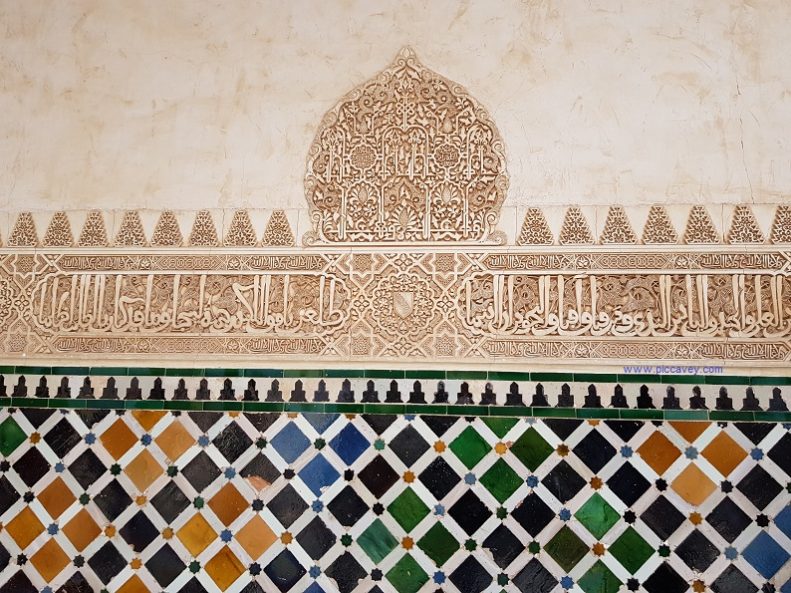
Above the tiles, higher up towards the walls geometrical shapes or poetic inscriptions abound. Towards the top of the walls quotations from the Koran appear, intentionally situated far from the ground.
Water and geometry are the main design elements in the Alhambra. Islamic culture does not accept the depiction of human images. Because of this the Alhambra walls have calligraphy, plant motifs and geometric patterns.
Cuarto Dorado, Alhambra
¨His Throne doth extend over the heavens and the earth,
and He feeleth no fatigue in guarding and preserving them
for He is the Most High, the Supreme (in glory).¨
¨From me you are welcomed morning and evening
by the tongues of blessing, prosperity, happiness and friendship¨
¨has decorated me with the robes of his glory and excellence
without disguise and has made me the throne of his empire
may its eminence be upheld by the master of divine glory and the celestial throne¨
The Throne Room
The design of this throne room is based of many square shapes. Consequently Mathematicians and architects appreciate this room due to it´s symmetry and precision. Also known as the Hall of the Ambassadors would have looked quite different that how we see it today. Because the room would have had brightly coloured rugs, beautiful vases and musical instruments around.
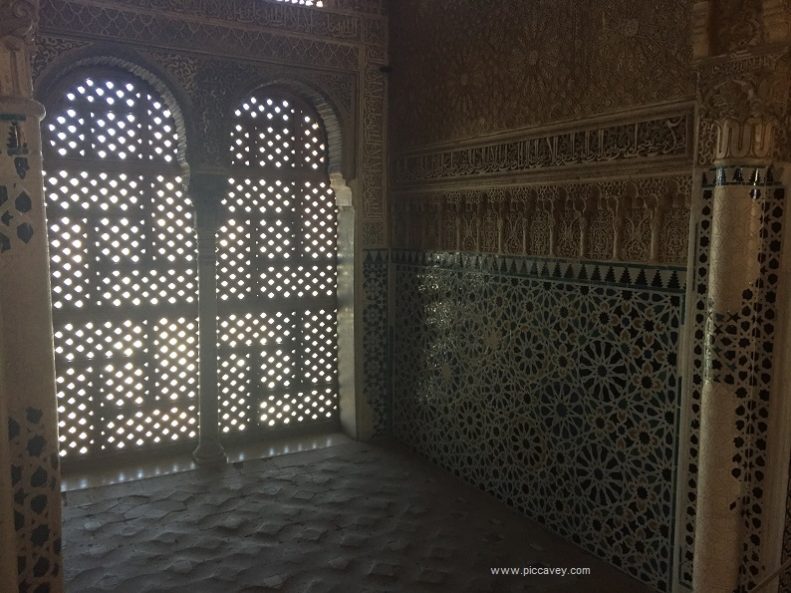
Silks inside the Alhambra
Also in the Alhambra silk was used extensively. They used only the best quality materials for covering walls, cushions and curtains. The silks would have been sumptuous colours and with intricate patterned designs. This decorative element is one which we can no longer appreciate today.
Certainly as this was the throne room, inscriptions here are more abundant:
Starry Ceilings
The intricate cedar wood ceiling has exacting measurements. Extremely difficult to put into place it consists of 8017 multicoloured panels. Symbolizing the seven heavens of Islamic Paradise. Diagonal lines radiate from the centre representing the four trees of life.
The ceiling is decorated with lots of stars. Painted to shine like ivory, mother of pearl and silver. Also worth noticing is the difference between the 8 pointed and 16 pointed stars.
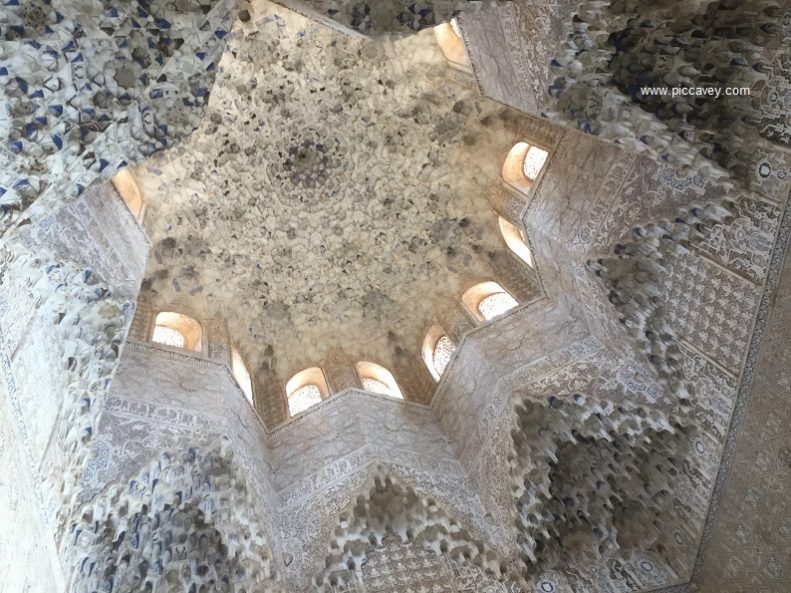
Most of the room would have been in a dim light, ensuring cooler temperatures. the latticework on the windows allows filtered light into the room. The effect of the light from the windows shone around the throne.
This would surround the sultan in diffused light in a dim room creating a position of power and mystery.
The throne used to be raised up slightly to give it height.
Another way to decorate a room was to write poems specifically for the space. Probably by the court poet Ibn Zamrak, (1333-1393). The hall of the two sisters is one of those, it´s verse wrapped around the impressive walls.
This room off the Courtyard of the Lions has two huge marble flagstones on the floor. They have the same dimensions on either side of the entrance. This white stone is from the town of Macael in Almeria. I´m sure that it was quite an ordeal moving these huge flagstones almost 200 kilometers in those days.
The ceiling in this room is breathtaking. Inside the white plasterwork creates a dramatic effect. These shapes are muqarnas . The Alhambra is the best example of Islam architecture in Europe.
Seems like it took many months and years of work to decorate the palace interiors.
The poem mentions this impressive architecture;
The portico is so beautiful that the palace
competes in beauty with the sky.
You dressed it with such an exquisite lamé,
that the loom of the Yemen is forgotten.
¡How many arches are high on its summit,
on the columns that are adorned by the light,
like spheres that turn
above the glowing pillar of the dawn!
The columns are so beautiful in every way,
that their success flies from mouth to ear:
the marble throws its clear light, which invades
the black corner that blackens the shadow;
its highlights iridesce, and one would say that
they are, in spite of their size, pearls.
El Peinador de la Reina
(This space is not usually open for public visit) I wanted to include this room as its a complete contrast to the other walls in the Alhambra.
Built in 1537 for the Queen Isabel after the conquest of the Alhambra Granada. Originally this was the Tower of Abu I Hayyay. This room is set high up in the tower and has spectacular views over the river and the Albayzin. This open balcony, opposite the Carrera del Darro, was a favourite spot for the Catholic Queen. She enjoyed hearing the voices of the people in the town below. Beacause they would be speaking arabic….

The wall painting are Italian style with rich colours. The frescos by Julio Aquiles and Alexander Mayner are of historical interest. They depict the expedition of Charles V to Tunisia in 1535. Scenes show the army´s departure from the port of Gagiliari, their withdrawal and their return to Sicily.
Other paintings include flowers, animals, angels and other decorative motifs. All set on a white or red background. The space is full of wall paintings and no area is undecorated.
Unfortunately the Catholic Queen never got to enjoy this space as we see it today as these frescos were painted between 1539-1546, Queen Isabel died in 1504.

Alhambra Inscriptions
Seems like there are infinite an of inscriptions in the Alhambra. So this is just a small compilation to give an idea of the detail along the palace walls.
https://www.piccavey.com/granada-alhambra-walls/














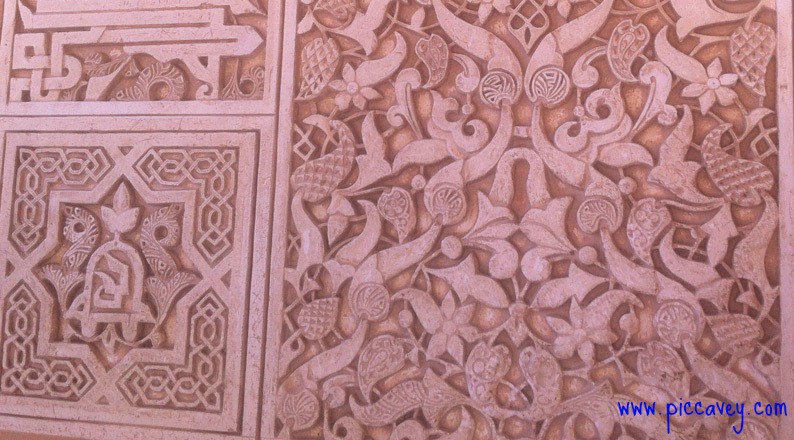

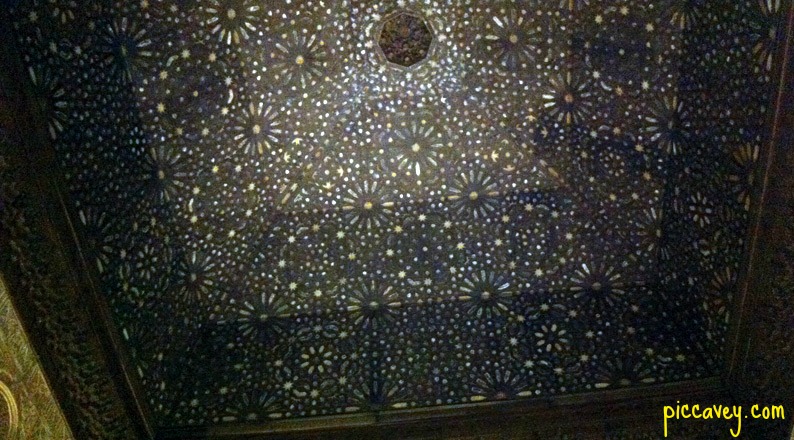
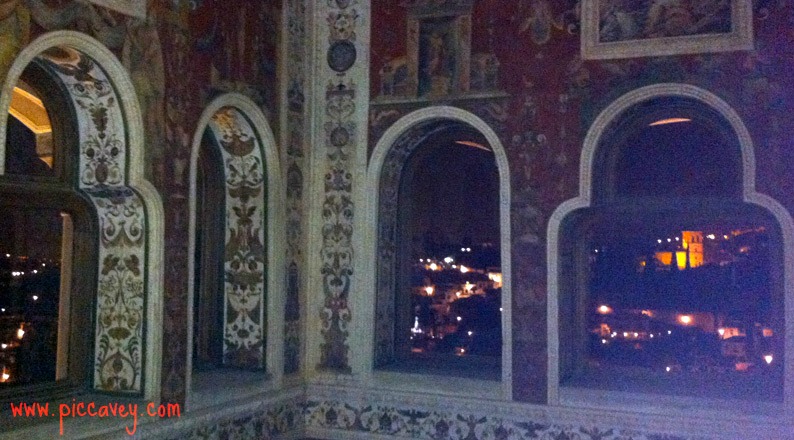
No comments:
Post a Comment